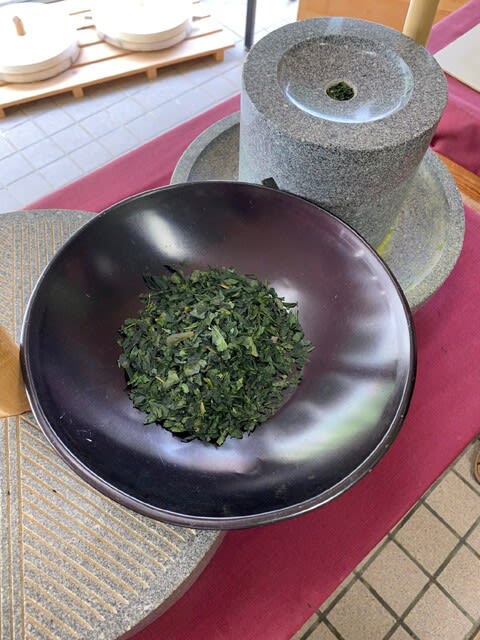ムクゲ


石臼

・石臼や機械を使って粉砕し、碾茶は粉末になり、抹茶になります。
・By using a millstone or a specialized machine the tencha becomes a powdered green tea, matcha.
・お抹茶として飲むものか、お菓子の材料等になる食材用なのか、用途によって、石臼挽きや機械
での粉砕などの粉砕方法を変えています。あの機械の中でたくさん行われているのは、石臼挽きです。
・The method of grinding, either by millstone or machine changes according to whether the matcha will be used as drinking matcha or as an ingredient in confections and such. Matcha.
・これは、1分間に50~60回転しています。碾茶をどのくらい細かくするかというと、茶道用抹茶は、5~10ミク ロン、つまり女性のファンデーションくらいです。1ミクロンは、0.001ミリメートルです。食材用は、もうちょっと大きく20ミクロンぐらいです。
・They turn at about 50 to 60 rotations per minute. As for how finely the tencha is ground, the powdered green tea used in tea ceremonies is only about 5 to 10 microns wide, in other words that’s about as fine as women’s foundation powder. For food purposes it’s a little larger at 20bmicrons.
・では、石臼を見てください。ここで使われている石臼は、隣の岡崎市で採掘された石を使って作られています。硬さや細かさなどが茶臼として最も適していると言われ、全国の抹茶専用の茶臼の多くが岡崎産です。
・Next, look at the millstones. The millstones used here are made from mined in the neighboring city of Okazaki. Because of its hardness, fine texture and so forth, the stone mined in this region is said to be the most suitable for tea grinding mortars. Many of the nation’s matcha dedicated tea mills are from Okazaki.
・石臼は反時計まわりにまわします。小さいものが子供用、粒の大きさが粗いです。粒が細かい方が苦みが軽減されます。ぜひ、なめてみて、その違いを確かめてみてください。
・Turn the millstone counterclockwise. The smaller one is for the children and it produces a coarse grain. The finer the grain, the less bitter it tastes. Please give it a lick and see the difference in taste for youself.
葵製茶で教えてもらいました。

・抹茶のもとになる碾茶は、この荒茶を風によって必要部分とそれ以外のくずに選別します。
・The unrefined tea is air-sorted selecting the necessary leaves and discarding the scraps.
・抹茶として必要な部分は、一番軽く一番遠くまで飛び、不要な部分である古い葉、茎は重たいので手前に落ちます。
・The leaves required for matcha are the lightest and are blown the furthest, the unneeded old leaves and stems are heavier, so they fall down to the front.
・また、茎の太い部分はほうじ茶の原料、細い部分は茎茶の原料になります。そして、古い葉は、豚や鶏のエサとして利用されます。
・Furthermore, the thick stems are used in hojicha, roasted green tea, and the thinner stems are used to make kukicha, twig or stem tea.
・このように選別された茶葉の形を整えるために切断したものを碾茶と言います。
・As a result, this selection of tea leaves that have been sorted in this way are called tencha.
・碾茶とは、荒茶から不純物を取り除いて茶葉のみに仕上げ、抹茶の粉になる前の段階の茶葉を言います。
・Tencha is the final selection of refined tea leaves obtained after removing the impurities from the unrefined tea, it is the name given to the leaves in the stage before they become a matcha powder.
・西尾市は、この碾茶の生産量が全国有数で、品質についても2019年の大会で日本一になりました。
・Nishio is the leading producer of tencha nationwide. And in terms of quality, it was awarded best in Japan in a 2019 competition.